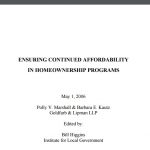Almost all jurisdictions require developers to execute some form of developer agreement. These agreements generally specify in detail how the inclusionary obligations will be met, which units will be designated as units meeting the requirements, and how construction and marketing of those units will be phased.
In some instances, development agreements are standalone documents. In many instances, they take the form an affordable housing plan attached as an exhibit to a master development agreement. In most but not all jurisdictions, inclusionary-related development agreements are recorded against title.
Despite the fact that almost all jurisdictions use developer agreements, most programs don’t rely on these agreements for enforcement of inclusionary requirements. Instead, jurisdictions use the issuance of building permits and/or occupancy permits as a way of enforcing inclusionary obligations.
In addition, many programs regularly inspect development projects under construction to ensure that inclusionary obligations are being met. Jurisdictions generally will issue the builder successive building permits only if the builder has passed these periodic inspections. The jurisdiction may also not issue occupancy permits until the builder has met the inclusionary obligations.




